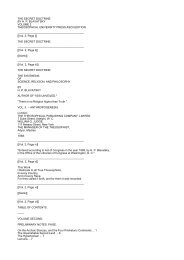Create successful ePaper yourself
Turn your PDF publications into a flip-book with our unique Google optimized e-Paper software.
Plate IV.<br />
Appendix: The usual title <strong>of</strong> this chapter [XXXB.] is, "Chapter <strong>of</strong> not allowing <strong>the</strong> heart <strong>of</strong> [<strong>the</strong><br />
deceased] to be driven away from him in <strong>the</strong> underworld."[1] it is an address by <strong>the</strong> deceased to his own<br />
heart, which he calls his ka or "double" within his body. It should be accompanied by a vignette <strong>of</strong> <strong>the</strong><br />
trial <strong>of</strong> <strong>the</strong> heart in which <strong>the</strong> heart is weighed against <strong>the</strong> dead man himself, as in <strong>the</strong> ancient Nebseni<br />
papyrus.<br />
In <strong>the</strong> Ani papyrus, however, it will be observed that <strong>the</strong> heart is being weighed against <strong>the</strong> fea<strong>the</strong>r <strong>of</strong> <strong>the</strong><br />
Law, Maat, a scene which <strong>of</strong>ten accompanies Chapter CXXV.<br />
Interesting variants <strong>of</strong> <strong>the</strong> vignettes <strong>of</strong> Chapter XXXB. are given by Naville (Todtenbuch, Bd. I., Bl. 43),<br />
where we find <strong>the</strong> deceased addressing ei<strong>the</strong>r his heart placed on a stand, or a beetle, or a heart to which<br />
are attached <strong>the</strong> antennæ <strong>of</strong> a beetle. In certain papyri this chapter is followed by a rubric:--"[This chapter<br />
is] to be said over a scarab[2] <strong>of</strong> green stone encircled with smu metal, and [having] a ring <strong>of</strong> silver,<br />
which is to be placed upon <strong>the</strong> neck <strong>of</strong> <strong>the</strong> dead. This chapter was found in Khemennu.[3]<br />
[1. ###<br />
2. Chapter XXXA. is never found inscribed upon scarabs.<br />
3. I.e., Hermopolis Magna, <strong>the</strong> metropolis <strong>of</strong> Un, <strong>the</strong> 15th nome <strong>of</strong> Upper Egypt, <strong>the</strong> city<br />
called ### by <strong>the</strong> Copts, and Eshmûnên, ### by <strong>the</strong> Arabs. It was <strong>the</strong> abode <strong>of</strong> <strong>the</strong> "eight" (xemennu) great primeval gods,<br />
and <strong>of</strong> Thoth, <strong>the</strong> scribe <strong>of</strong> <strong>the</strong> gods. (See Meyer and Dümichen, Geschichte des alten Agyptens, p. 185.)]<br />
{p. 262}<br />
written upon a slab <strong>of</strong> steel <strong>of</strong> <strong>the</strong> South, in <strong>the</strong> writing <strong>of</strong> <strong>the</strong> god himself, under <strong>the</strong> feet <strong>of</strong> <strong>the</strong> majesty<br />
<strong>of</strong> <strong>the</strong> god, in <strong>the</strong> time <strong>of</strong> <strong>the</strong> majesty <strong>of</strong> Men-kau-Ra,[1] <strong>the</strong> king <strong>of</strong> <strong>the</strong> North and <strong>of</strong> <strong>the</strong> South,<br />
triumphant, by <strong>the</strong> royal son Heru-tata-f[2] who found it while he was journeying to inspect <strong>the</strong><br />
temples."[3]<br />
The scarabs which are found in <strong>the</strong> mummies, or lying upon <strong>the</strong> breast just above <strong>the</strong> position <strong>of</strong> <strong>the</strong><br />
heart, form an interesting section <strong>of</strong> every large Egyptian collection. In <strong>the</strong> British Museum series every<br />
important type <strong>of</strong> <strong>the</strong> funereal scarab is represented. They are made <strong>of</strong> green basalt, green granite (Nos.<br />
7894 and 15,497), white limestone (Nos. 7917, 7927, 15,508), light green marble (No. 7905), black stone<br />
(Nos. 7907, 7909, 7913), blue paste (Nos. 7904, 14,549), blue glass (No. 22,872), and purple, blue, or<br />
green glazed faïence (Nos. 7868, 7869). They vary in size from 5 inches to 2 inches in length. On <strong>the</strong><br />
hard stone examples <strong>the</strong> text <strong>of</strong> <strong>the</strong> Chapter <strong>of</strong> <strong>the</strong> Heart, more or less complete, is usually cut on <strong>the</strong> base<br />
http://www.sacred-texts.com/egy/ebod/ebod16.htm (3 <strong>of</strong> 4) [8/10/2001 11:25:24 AM]

















